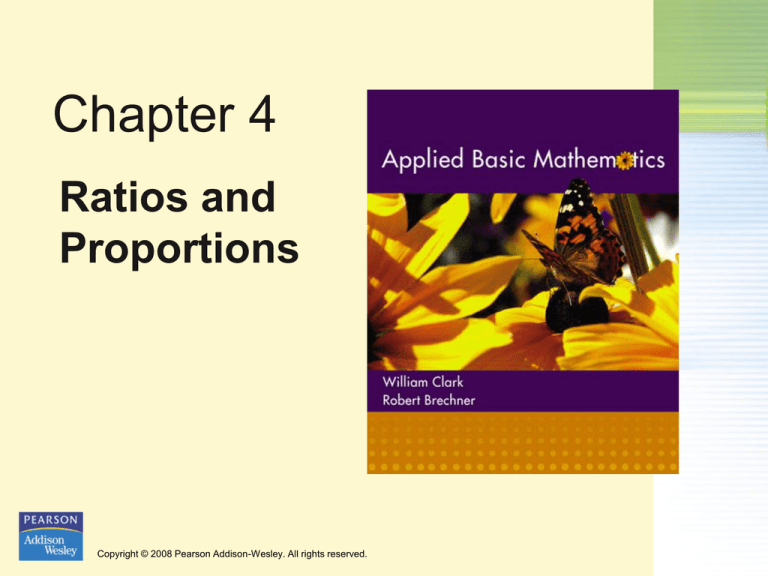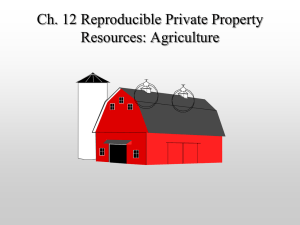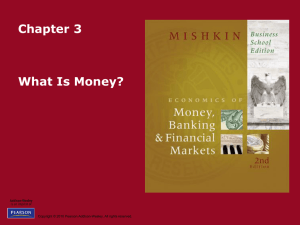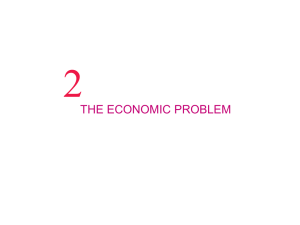
Chapter 4
Ratios and
Proportions
Copyright © 2008 Pearson Addison-Wesley. All rights reserved.
Section 4.2
Working with Rates and Units
Copyright © 2008 Pearson Addison-Wesley. All rights reserved.
4-2-2
Understanding a Rate
A rate is a ratio that compares two quantities that
have different kinds of units.
Two common rates are unit rates and unit prices.
Some examples are: miles per hour, calories per
serving, and price per unit.
Copyright © 2008 Pearson Addison-Wesley. All rights reserved.
4-2-3
Write and Interpret a Rate
Rates are written in fraction notation with the
units included.
We include the units because they are different and
therefore do not divide out.
It is important to keep in mind what “comparative
fact” the rate is actually stating.
Copyright © 2008 Pearson Addison-Wesley. All rights reserved.
4-2-4
Example
Write each rate as a simplified fraction.
Then write the rate in word form.
a. 225 horses on 10 acres
b. 525 miles on 18 gallons of fuel
c. 520 calories for 12 cookies
Copyright © 2008 Pearson Addison-Wesley. All rights reserved.
4-2-5
Solution Strategy
Write each rate as a simplified fraction.
Then write the rate in word form.
a. 225 horses on 10 acres
45
225 horses
225 horses 45 horses
10 acres
2 acres
10 acres
2
45 horses for every 2 acres
Copyright © 2008 Pearson Addison-Wesley. All rights reserved.
4-2-6
Solution Strategy
Write each rate as a simplified fraction.
Then write the rate in word form.
b. 525 miles on 18 gallons of fuel
175
525 miles
525 miles 175 miles
18 gallons
18 gallons 6 gallons
3
175 miles for every 6 gallons of fuel
Copyright © 2008 Pearson Addison-Wesley. All rights reserved.
4-2-7
Solution Strategy
Write each rate as a simplified fraction.
Then write the rate in word form.
c. 520 calories for 12 cookies
130
520 calories 520 calories 130 calories
12 cookies
3 cookies
12 cookies
3
130 calories for every 3 cookies
Copyright © 2008 Pearson Addison-Wesley. All rights reserved.
4-2-8
Writing a Unit Rate
A unit rate is a rate in which the number in the
denominator is 1.
A common example would be miles per gallon.
Let’s say that a car travels 160 miles on 8
gallons of fuel. Our unit rate would be written
as a fraction and then simplified by dividing
out the common factor, 8.
Copyright © 2008 Pearson Addison-Wesley. All rights reserved.
4-2-9
Writing a Unit Rate
Copyright © 2008 Pearson Addison-Wesley. All rights reserved.
4-2-10
Example
Write each as a unit rate.
Round to the nearest tenth, if necessary.
a. 625 people in 5 days
b. 145 miles in 3 hours
Copyright © 2008 Pearson Addison-Wesley. All rights reserved.
4-2-11
Solution Strategy
Write each as a unit rate.
Round to the nearest tenth, if necessary.
a. 500 people in 4 days
625 people
= 125 people per day
5 days
b. 145 miles in 3 hours
145 miles
= 45 miles per hour
3 hours
Copyright © 2008 Pearson Addison-Wesley. All rights reserved.
4-2-12
Writing a Unit Price
A common application of unit rate is unit price.
A unit price is a rate expressed as price per
single item of something.
It tells us the “price per item” or “price per
measure” of a particular product or service.
Copyright © 2008 Pearson Addison-Wesley. All rights reserved.
4-2-13
Writing a Unit Price
Copyright © 2008 Pearson Addison-Wesley. All rights reserved.
4-2-14
Example
Calculate the unit price for each.
Round to the nearest cent, if necessary.
a. 4 light bulbs for $5.40
b. a dozen eggs for $2.16
Copyright © 2008 Pearson Addison-Wesley. All rights reserved.
4-2-15
Solution Strategy
Calculate the unit price for each.
Round to the nearest cent, if necessary.
a. 4 light bulbs for $5.40
$5.40
= $1.35 per bulb
4 bulbs
b. a dozen eggs for $2.16
$2.16
= $0.18 per egg
12 eggs
Copyright © 2008 Pearson Addison-Wesley. All rights reserved.
4-2-16
Example
Apply your knowledge
A local grocer sells a 16-ounce can of soda for
$1.25 and a 20-ounce bottle of the same type of
soda for $1.50.
a. What is the unit price for each product?
Round to the nearest cent.
b. Based on unit price, which size is the best
buy?
Copyright © 2008 Pearson Addison-Wesley. All rights reserved.
4-2-17
Solution Strategy
A local grocer sells a 16-ounce can of soda for
$1.25 and a 20-ounce bottle of the same type of
soda for $1.50.
a. What is the unit price for each product?
Round to the nearest cent.
$1.25
unit price
= $0.08 ounces per can
(can):
16 ounces
$1.50
unit price
= $0.075 ounces per can
(bottle): 20 ounces
Copyright © 2008 Pearson Addison-Wesley. All rights reserved.
4-2-18
Solution Strategy
A local grocer sells a 16-ounce can of soda for
$1.25 and a 20-ounce bottle of the same type of
soda for $1.50.
b. Based on unit price, which size is the best
buy?
The best buy is the product with the lower
unit price.
The best buy is the 20-ounce bottle.
Copyright © 2008 Pearson Addison-Wesley. All rights reserved.
4-2-19







